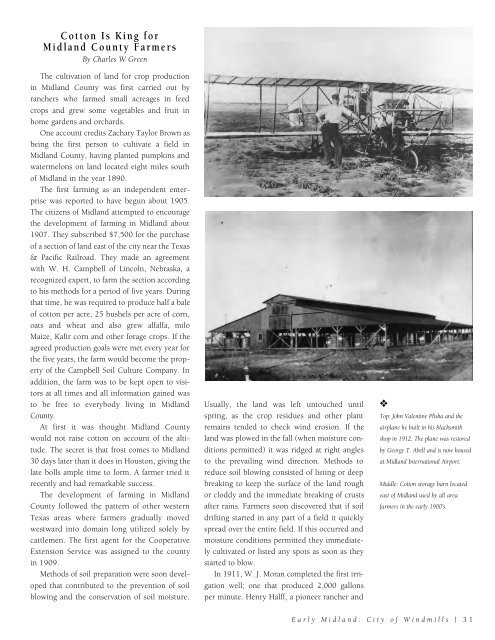Historic Midland
An illustrated history of the Midland County area, paired with the histories of companies, families and organizations that make the region great.
An illustrated history of the Midland County area, paired with the histories of companies, families and organizations that make the region great.
Create successful ePaper yourself
Turn your PDF publications into a flip-book with our unique Google optimized e-Paper software.
Cotton Is King for<br />
<strong>Midland</strong> County Farmers<br />
By Charles W. Green<br />
The cultivation of land for crop production<br />
in <strong>Midland</strong> County was first carried out by<br />
ranchers who farmed small acreages in feed<br />
crops and grew some vegetables and fruit in<br />
home gardens and orchards.<br />
One account credits Zachary Taylor Brown as<br />
being the first person to cultivate a field in<br />
<strong>Midland</strong> County, having planted pumpkins and<br />
watermelons on land located eight miles south<br />
of <strong>Midland</strong> in the year 1890.<br />
The first farming as an independent enterprise<br />
was reported to have begun about 1905.<br />
The citizens of <strong>Midland</strong> attempted to encourage<br />
the development of farming in <strong>Midland</strong> about<br />
1907. They subscribed $7,500 for the purchase<br />
of a section of land east of the city near the Texas<br />
& Pacific Railroad. They made an agreement<br />
with W. H. Campbell of Lincoln, Nebraska, a<br />
recognized expert, to farm the section according<br />
to his methods for a period of five years. During<br />
that time, he was required to produce half a bale<br />
of cotton per acre, 25 bushels per acre of corn,<br />
oats and wheat and also grew alfalfa, milo<br />
Maize, Kafir corn and other forage crops. If the<br />
agreed production goals were met every year for<br />
the five years, the farm would become the property<br />
of the Campbell Soil Culture Company. In<br />
addition, the farm was to be kept open to visitors<br />
at all times and all information gained was<br />
to be free to everybody living in <strong>Midland</strong><br />
County.<br />
At first it was thought <strong>Midland</strong> County<br />
would not raise cotton on account of the altitude.<br />
The secret is that frost comes to <strong>Midland</strong><br />
30 days later than it does in Houston, giving the<br />
late bolls ample time to form. A farmer tried it<br />
recently and had remarkable success.<br />
The development of farming in <strong>Midland</strong><br />
County followed the pattern of other western<br />
Texas areas where farmers gradually moved<br />
westward into domain long utilized solely by<br />
cattlemen. The first agent for the Cooperative<br />
Extension Service was assigned to the county<br />
in 1909.<br />
Methods of soil preparation were soon developed<br />
that contributed to the prevention of soil<br />
blowing and the conservation of soil moisture.<br />
Usually, the land was left untouched until<br />
spring, as the crop residues and other plant<br />
remains tended to check wind erosion. If the<br />
land was plowed in the fall (when moisture conditions<br />
permitted) it was ridged at right angles<br />
to the prevailing wind direction. Methods to<br />
reduce soil blowing consisted of listing or deep<br />
breaking to keep the surface of the land rough<br />
or cloddy and the immediate breaking of crusts<br />
after rains. Farmers soon discovered that if soil<br />
drifting started in any part of a field it quickly<br />
spread over the entire field. If this occurred and<br />
moisture conditions permitted they immediately<br />
cultivated or listed any spots as soon as they<br />
started to blow.<br />
In 1911, W. J. Moran completed the first irrigation<br />
well; one that produced 2,000 gallons<br />
per minute. Henry Halff, a pioneer rancher and<br />
❖<br />
Top: John Valentine Pliska and the<br />
airplane he built in his blacksmith<br />
shop in 1912. The plane was restored<br />
by George T. Abell and is now housed<br />
at <strong>Midland</strong> International Airport.<br />
Middle: Cotton storage barn located<br />
east of <strong>Midland</strong> used by all area<br />
farmers in the early 1900’s.<br />
Early <strong>Midland</strong>: City of Windmills | 31
















